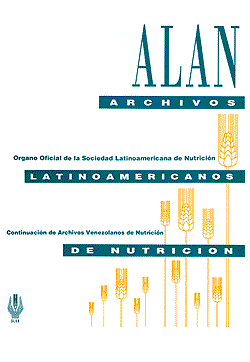Percentile distribution of anthropometric variables in pregnant women
Keywords:
Percentile Distributio, Pregnancy, Anthropometry, Assessment of Nutritional Status, Distribución Percentilar, Embarazo, Antropometría, Evaluación NutricionalAbstract
Anthropometric indicators play an important role in the health status assessment of individuals and populations across the different vulnerable groups, due to which it is necessary to ascertain the percentile distribution of the weight, body mass index (BMI), and mid-arm, thigh, and calf circumferences in pregnant women for each week of gestational age. This descriptive and cross-sectional study included 4,481 measurements of anthropometric variables obtained from 745 pregnancies out of 719 subjects aged between 19 and 39 years, who were well-nourished, healthy, without clinical edema in the third trimester, with single pregnancy, and validated gestational age. All evaluations were conducted at the Centro de Atención Nutricional Infantil Antímano, CANIA, from 1998 to 2012. The anthropometric measurements were performed by standardized anthropometrists. Measures of central tendency and dispersion, bivariate correlations, and percentiles 3, 10, 25, 50, 75, 90, and 97 were calculated for each gestational age, between the 8th and 37th weeks of gestation. The number of measurements performed for each studied variable ranged from a minimum of 101 and a maximum of 241 at each gestational week. The BMI and circumference behaviors showed increases as the gestational age advanced. The changes in the variables observed in the 50th percentile between weeks 8 thru 37 were: weight, 10.10 kg; BMI, 4.23 kg/m2; and circumferences (cm): mid-arm, 0.45; calf, 1.60; and thigh, 3.55. The results of this study provide the means to simplify the screening and follow-up of the nutritional status in an accurate manner at any stage of gestation until the 37th week.
Los indicadores antropométricos juegan un papel importante en la evaluación el estado de salud a nivel individual y poblacional en los diferentes grupos vulnerables por lo que resulta necesario conocer la distribución percentilar del peso, índice de masa corporal (IMC) y circunferencias: media del brazo, muslo y pierna, para cada edad gestacional. Estudio descriptivo, de corte transversal, incluyó 4484 mediciones de las variables antropométricas obtenidas de 745 embarazos, provenientes de 719 mujeres, con edades comprendidas entre 19 y 39 años, sanas, eutróficas, sin edema, con embarazo simple y edad gestacional validada, evaluadas en el Centro de Atención Nutricional Infantil Antímano, desde 1998 hasta el 2012. Las mediciones antropométricas fueron realizadas por antropometristas estandarizadas. Se calcularon medidas de tendencia central y de dispersión, así como correlaciones bivariantes y percentiles 3, 10, 25, 50, 75, 90 y 97 para cada edad gestacional, entre las 8 y 37 semanas de gestación. El número de mediciones realizadas para cada variable analizada varió entre 101 y 241 por edad gestacional. El comportamiento del IMC y circunferencias evidenció incrementos a medida que aumenta la edad gestacional. Los cambios referidos al percentil 50 de las variables, de las semanas de gestación 8 a la 37 fueron: peso 10,10 kg; IMC 4,23 Kg/m2; circunferencias (cm): media del brazo 0,45; pierna 1,60; muslo 3,55. Los resultados de este estudio constituyen una herramienta que simplifica la evaluacion inicial y el seguimiento del estado nutricional de manera puntual en cualquier momento de la gestacion hasta las 37 semanas de edad gestacional.
Downloads
Downloads
How to Cite
Issue
Section
License
Usted es libre de:
Compartir — copiar y redistribuir el material en cualquier medio o formato
Adaptar — remezclar, transformar y construir a partir del material
La licenciante no puede revocar estas libertades en tanto usted siga los términos de la licencia
Bajo los siguientes términos:
Atribución — Usted debe dar crédito de manera adecuada, brindar un enlace a la licencia, e indicar si se han realizado cambios. Puede hacerlo en cualquier forma razonable, pero no de forma tal que sugiera que usted o su uso tienen el apoyo de la licenciante.
NoComercial — Usted no puede hacer uso del material con propósitos comerciales.
No hay restricciones adicionales — No puede aplicar términos legales ni medidas tecnológicas que restrinjan legalmente a otras a hacer cualquier uso permitido por la licencia.




